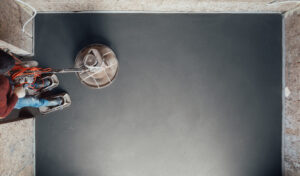As you explore the possibilities of revamping your residential or commercial space in Alexandria, VA, you might find your thoughts gravitating toward the world of concrete polishing. This process can utterly transform concrete surfaces, such as floors or countertops, giving them a slick, glossy finish that needs no waxing.
Concrete has garnered significant popularity as a material for flooring and countertops due to its resilience, low upkeep, and beautiful sheen it can achieve through polishing. This article aims to clarify your queries about concrete polishing, its suitability for various projects, and the distinct methods employed for this purpose.
Concrete Polishing – The Basics
Drawing a parallel to the process of a craftsman smoothing the rough edges of wood with sandpaper, a concrete polisher utilizes machinery to grind the concrete to a gleaming finish. Starting with a rougher grit, the process gradually escalates to a very fine one. The final result is a glossy, reflective concrete surface, the shine of which can be regulated by using different polishing techniques.
The polishing process typically involves a metallic matrix embedded with coarse diamond fragments to grind the concrete. The number of passes required with the coarsest setting depends on the concrete’s condition and the desired result, generally ranging between three to five passes. Once this is complete, the concrete polishers switch to a plastic resin matrix embedded with diamonds, progressively using finer polishing disks until the desired final grit is achieved.
Following this, an impregnating sealer is applied to enhance and safeguard the concrete further. This step also lessens the effort required to maintain the concrete floors later. For an extra touch of gloss, a contractor might apply a polishing compound, which also increases the floor’s resistance to dirt, making long-term cleaning easier.
 Ideal Locations for Concrete Flooring
Ideal Locations for Concrete Flooring
Concrete floors, with their easy maintenance, high durability, and long-lasting nature, are finding their way from industrial spaces to contemporary homes. They are also easy to clean, adding to their appeal. Some of the usual settings where concrete flooring can be spotted include:
· Auto museums or display rooms
· Workspaces
· Eateries
· Shopping complexes or retail outlets
· Warehouses or aircraft hangars
· Modern residential properties
The Merits of Choosing Concrete
Concrete floors are not only sturdy and easy to maintain, but they also outlive most other flooring alternatives. Unlike different flooring types that necessitate frequent wax reapplication, polished concrete floors require less maintenance. They reflect light effectively, enhancing the overall luminosity of space, and do not need hazardous chemicals for cleaning or coating. This makes them a more environmentally friendly flooring option.
Which Concrete Projects Are Suitable for Polishing?
Before you embark on a concrete polishing spree, remember that certain protocols must be observed for effective polishing. For instance, concrete must be allowed to cure for at least 28 days post-pouring before it can be polished. This also applies to kitchen countertops and cement furniture like benches that you plan to polish.
Moreover, not every concrete floor is a good candidate for polishing. Uneven floors, riddled with bubbles, or overly porous are often best left unpolished. If you’re unsure about your concrete floor’s suitability for polishing, reach out to the concrete experts at Concrete, Etc.
Are Polished Concrete Floors Slippery?
Polished concrete floors can reach a high level of glossiness, which might raise concerns about their slipperiness. However, barring the presence of standing water, grease, or oil, these floors are unlikely to be any more slippery than other flooring types. Some manufacturers even offer anti-slip conditioners that enhance your concrete floor’s traction. Applying this conditioner is as easy as mopping it on post-regular cleaning, though it needs to be reapplied regularly.
If slipperiness is a concern, there are alternatives available. You can add anti-slip grit during the polishing process, which will enhance traction without changing the look of the finish. If the area is heavily used and you’re worried about slips and falls, consider rubber mats or throw rugs. They can also provide comfort for those standing on concrete floors for extended periods, such as in a kitchen.
Understanding Different Concrete Polishing Techniques
For concrete aficionados, one polishing method does not fit all. That’s why there are three primary types of concrete polishing: wet polishing, dry polishing, and combination polishing.
Wet polishing requires water for dust control and to cool and lubricate the abrasive diamond matrices during the process. While it does enhance the lifespan of the polishing materials by protecting them from heat friction or wear and tear, it creates a fair amount of mess as the floor will be covered in a mixture of ground concrete and water.
On the other hand, dry polishing does not involve water. Most contractors prefer this method as it involves less cleanup, thanks to dust collection devices. Dry polishing also tends to be more popular with contractors not worried about frequently replacing their polishing tools.
Combination polishing starts dry and switches to wet when finer grits are involved. This method protects the resin-bonded abrasives and creates less mess since more concrete is removed during the first few passes with a coarser grit.
Choosing Concrete Polishing in Alexandria, VA Concrete floors, with their polished look, low maintenance, durability, and eco-friendliness, are increasingly becoming common in workspaces, industrial settings, and modern homes. With the current state of the supply chain and the rising cost of traditional flooring materials, this trend doesn’t seem to be reversing any time soon.
If you’re considering these sturdy, water-resistant, and mold-resistant concrete floors for your space, get in touch with Concrete, Etc. today for a consultation, or click here to check out our previous work!


 Ideal Locations for Concrete Flooring
Ideal Locations for Concrete Flooring